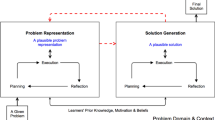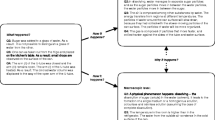Abstract
This study examined patterns of scientific understanding using an open-ended learning environment (OELE). Four seventh-graders were drawn from a general science class and were studied as separate cases. The OELE was the ErgoMotion program on mechanical physics, which combines computer-generated graphics, computer simulations, video, and print-based materials. Primary data collection techniques included think-aloud protocols and interviews. The results indicated that learners perceived information from the system, derived interpretations to explain observations, and used system features to test interpretations. Learners also, however, tended to perceive and interpret information inaccurately. While learners built and formalized scientific theories, they often failed to use system data to evaluate the limitations of their understanding. In some cases, they assimilated new data into existing theories, ignored inconsistent data, or derived independent theories to account for contradictory evidence. This study indicated that powerful intuitive theories, which are highly resistant to change, influence the interpretation of system events.
Similar content being viewed by others
References
Ackermann, E. (1991). From decontextualized to situated knowledge: Revisiting Piaget's water-level experiment. In I. Harel & S. Papert (Eds.),Constructionism (pp. 269–294). Norwood, NJ: Ablex Publishing Corporation.
Atkins, M., & Blissett, G. (1992). Interactive video and cognitive problem-solving skills.Educational Technology, 32(1), 44–50.
Bowen, C. (1992).Student and teacher outcomes: Results from national field testing with IMS's ScienceVision materials. Technical report #1; Interactive Media Science Project, Florida State University.
Brown, J.S., Collins, A., & Duguid, P. (1989). Situated cognition and the culture of learning.Educational Researcher, 18(1), 32–41.
Bruner, J. (1961). The act of discovery.Harvard Educational Review, 31(1), 21–32.
Carey, S. (1986). Cognitive science and science education.American Psychologist, 41(10), 1123–1130.
Champagne, A., Gunstone, R., & Klopfer, L. (1985). Instructional consequences of students' knowledge about physical phenomena. In L.H.T. West & A.L. Pines (Eds.),Cognitive structure and conceptual change (pp. 61–90). Orlando: Academic Press.
Chan, C., Burtis, P., Scardamalia, M., & Bereiter, C. (1992). Constructive activity in learning from text.American Educational Research Journal, 29(1), 97–118.
Chi, M., Glaser, R., & Rees, E. (1982). Expertise in problem solving. In R. Sternberg (Ed.),Advances in the psychology of human intelligence (Vol. 1, pp. 7–75). Hillsdale, NJ: Erlbaum.
Choi, J-I., & Hannafin, M.J. (in press). The effects of instructional context and reasoning complexity on mathematics problem solving.Educational Technology Research and Development.
Cognition and Technology Group at Vanderbilt. (1992). The Jasper experiment: An exploration of issues in learning and instructional design.Educational Technology Research and Development, 40(1), 65–80.
Dewey, J. (1933).How we think. Boston: Heath.
Dewey, J. (1938).Experience and education. New York: Collier Macmillan.
Dick, W. (1991). An instructional designer's view of constructivism.Educational Technology, 31(5), 41–44.
diSessa, A., & White, B. (1982). Learning physics from a dynaturtle.Byte, 7, 324.
Driscoll, M.P. (1995). Paradigms for research in instructional systems. In G. Anglin (Ed.),Instructional technology: Past, present, and future (2nd ed.) (pp. 322327). Englewood, CO: Libraries Unlimited, Inc.
Driver, & Scanlon. (1988). Conceptual change in science.Journal of Computer-Assisted Learning (5), 25–36.
Edwards, L. (1995). The design and analysis of a mathematical microworld.Journal of Educational Computing Research, 12(1), 77–94.
Ericsson, K.A., & Simon, H.A. (1992).Protocol analysis: Verbal reports as data. Cambridge: The MIT Press.
Guba, E.G., & Lincoln, Y. (1982). Epistemological and methodological bases of naturalistic inquiry.ECTJ, 30(4), 233–252.
Hannafin, M.J. (1992). Emerging technologies, ISD, and learning environments: Critical perspectives.Educational Technology Research and Development, 40(1), 49–63.
Hannafin, M.J., Hall, C., Land, S.M., & Hill, J.R. (1994). Learning in an open-ended environment: Assumptions, methods, and implications.Educational Technology, 34(8), 48–55.
Hannafin, M.J., & Land, S.M. (in press). The foundations and assumptions of technology-enhanced student-centered learning environments.Instructional Science.
Harel, I., & Papert, S. (1991). Software design as a learning environment. In I. Harel & S. Papert (Eds.),Constructionism (pp. 41–84). Norwood, NJ: Ablex.
Hawkins, J., & Pea, R. (1987). Tools for bridging the cultures of everyday and scientific thinking.Journal of Research in Science Teaching, 24(4), 291–307.
Hashweh, M. (1988). Descriptive studies of student's conceptions in science.Journal of Research in Science Teaching, 25(2), 121–134.
Hill, J. (1995).Cognitive strategies and the use of a hypermedia information system: An exploratory study. Unpublished doctoral dissertation, Florida State University.
Holland, J., Holyoak, K., Nisbett, R., & Thargard, P. (1986).Induction: Processes of inference, learning, and discovery. Cambridge, MA: MIT Press.
Jacob, E. (1987). Qualitative research traditions: A review.Review of Educational Research, 57(1), 1–50.
Jonassen, D. (1984). The mediation of experience and educational technology: A philosophical analysis.Educational Technology Research and Development, 32(3), 153–167.
Jonassen, D. (1991). Objectivism versus constructivism: Do we need a new philosophical paradigm?Educational Technology Research and Development, 39(3), 5–14.
Karmiloff-Smith, A., & Inhelder, B. (1975). If you want to get ahead, get a theory.Cognition, 3(3), 195–212.
Kember, D., & Murphy, D. (1990). Alternative new directions for instructional design.Educational Technology, 30(8), 42–47.
Kozma, R.B. (1987). The implications of cognitive psychology for computer-based learning tools.Educational Technology, 27(11), 20–25.
Land, S.M., & Hannafin, M.J. (1996). A conceptual framework for the development of theories-inaction with open-ended learning environments.Educational Technology Research and Development, 44(3), 37–53.
Lebow, D. (1993). Constructivistic values for instructional systems design: Five principles toward a new mindset.Educational Technology Research and Development, 41(3), 4–16.
Lewis, E., & Linn, M. (1994). Heat energy and temperature concepts of adolescents, adults, and experts: Implications for curricular improvements.Journal of Research in Science Teaching, 31(6), 657–677.
Lewis, E., Stern, J., & Linn, M. (1993). The effect of computer simulations on introductory thermodynamics understanding.Educational Technology, 33(1), 45–58.
Lincoln, Y., & Guba, E. (1985).Naturalistic inquiry. Newbury Park, CA: Sage.
Linn, M., & Muilenburg, L. (1996). Creating lifelong science learners: What models form a firm foundation?Educational Researcher, 25(5), 18–24.
Litchfield, B., & Mattson, S. (1989). The interactive media science project: An inquiry-based multimedia science curriculum.Journal of Computers in Mathematics and Science Teaching, 9(1), 37–43.
Mayer, R.E. (1984). Aids to text comprehension.Educational Psychologist, 19, 30–42.
Mayer, R.E. (1989). Models for understanding.Review of Educational Research, 59, 43–64.
Merriam, S. (1988).Case study research in education: A qualitative approach. San Francisco: Jossey-Bass.
Miles, M.B., & Huberman, A.M. (1984).Qualitative data analysis: A sourcebook of new methods. Newbury Park, CA: Sage.
National Science Teachers' Association. (1993).NSTA standards for science teacher preparation: An NSTA position statement. Washington, DC: National Science Teachers' Association.
Papert, S. (1993a).The children's machine: Rethinking school in the age of the computer. New York: Basic Books, Inc.
Papert, S. (1993b).Mindstorms (2nd ed.). New York: Basic Books, Inc.
Pea, R.D., (1993). Practices of distributed intelligence and designs for education. In G. Salomon's (Ed.),Distributed intelligence (pp. 47–87). New York: Cambridge.
Perkins, D. (1991). Technology meets constructivism: Do they make a marriage?Educational Technology, 31(5), 18–23.
Perkins, D., & Simmons, R. (1988). Patterns of mis-understanding: An integrative model for science, math, and programming.Review of Educational Research, 58, 303–326.
Petre, M. (1995). Readership skills and graphical programming.Communication of the ACM, 38(6), 33–43.
Phillips, D.C. (1995). The good, the bad, and the ugly: The many faces of constructivism.Educational Researcher, 24(7), 5–12.
Piaget, J. (1970).The child's conception of movement and speed. New York: Ballantine.
Piaget, J. (1976).,The grasp of consciousness. Cambridge, MA: Harvard University Press.
Rieber, L.P. (1992). Computer-based microworlds: A bridge between constructivism and direct instruction.Educational Technology Research and Development, 40(1), 93–106.
Robinson, R.S. (1995). Qualitative research—A case for case studies. In G. Anglin (Ed.),Instructional technology: Past, present and future (2nd ed.). (pp. 330–337). Englewood, CO: Libraries Unlimited, Inc.
Roth, W.M., & Roychoudhury, A. (1993). The development of science process skills in authentic contexts.Journal of Research in Science Teaching, 30(2), 127–152.
Salomon, G. (1986). Information technologies: What you see is not (always) what you get.Educational Psychologist, 20, 207–216.
Salomon, G., Globerson, T., & Guterman, E. (1989). The computer as a zone of proximal development: Internalizing reading-related metacognitions from a reading partner.Journal of Educational Psychology, 81(4), 620–627.
Scardamalia, M., Bereiter, C., McLean, R., Swallow, J., & Woodruff, E. (1989). Computer-supported intentional learning environments.Journal of Educational Computing Research, 5(1), 51–68.
Schön, D.A. (1983).The reflective practitioner: How professionals think in action. New York: Basic Books.
Spiro, R., Feltovich, P., Jacobson, M., & Coulson, R. (1991). Cognitive flexibility, constructivism, and hypertext: Random access instruction for advanced knowledge acquisition in ill-structured domains.Educational Technology, 31(5), 24–33.
Steinberg, E. (1977). Review of student control in computer-assisted instruction.Journal of Computer-Based Instruction, 3, 84–90.
Steinberg, E. (1989). Cognition and learner control: A literature review, 1977–1988.Journal of Computer-Based Instruction, 16, 117–121.
Strauss, A., & Corbin, J. (1990).Basics of qualitative research: Grounded theory procedures and techniques. Newbury Park, CA: Sage Publications.
Tobin, K., & Dawson, G. (1992). Constraints to curriculum reform: Teachers and the myths of schooling.Educational Technology Research and Development, 40(1), 64–92.
Twigger, D., Byard, M., Draper, S., Driver, R., Hartley, R., Hennessey, S., Mallen, C., Mohamed, R., O'Malley, C., O'Shea, T., Scanlon, E. (1991). The ‘Conceptual change in science’ project.Journal of Computer-Assisted Learning, 7, 144–155.
Vosniadou, S., & Brewer, W. (1987). Theories of knowledge restructuring in development. Review ofEducational Research, 57(1), 51–67.
Vosniadou, S. (1992). Knowledge acquisition and conceptual change.Applied Psychology: An International Review, 41(4), 347–357.
Wilson, T., & Brekke, N. (1994). Mental contamination and mental correction: Unwanted influences on judgments and evaluations.Psychological Bulletin, 116(1), 117–142.
Yin, R. (1994).Case study research (2nd ed.). Newbury Park, CA: Sage Publications.
Author information
Authors and Affiliations
Additional information
This manuscript is based on the doctoral dissertation by the first author conducted at The Florida State University. We wish to acknowledge Dr. Marcy P. Driscoll, Dr. Robert A. Reiser, and Dr. Richard K. Wagner for their cooperation and support as committee members, and George Dawson for providing use of ErgoMotion. The manuscript was prepared while the first author was working as a postdoctoral fellow at The University of Georgia's Learning and Performance Support Laboratory.
Rights and permissions
About this article
Cite this article
Land, S.M., Hannafin, M.J. Patterns of understanding with open-ended learning environments: A qualitative study. ETR&D 45, 47–73 (1997). https://doi.org/10.1007/BF02299524
Issue Date:
DOI: https://doi.org/10.1007/BF02299524




